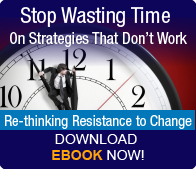We’ve all experienced it. The quiet whispers in the break room; the angry outbursts in a team meeting; the under the breath mutterings in the hallways. Phrases like, “This is never going to work.” Or, “I’m not changing the way I’ve done my job for the last umpteen years.” Or one of our all-time favorites, “We tried this years ago, and it didn’t work.” Change Agents and Sponsors face these and many other forms of resistance on a daily basis. 
Resistance to change is just way for people to protect themselves against changes in their job tasks, work behaviors, performance measures, power and/or status. Resistance is a function of disruption. If you are a Change Agent, you can anticipate that the more someone believes their current habits and patterns will be impacted, the greater the degree of resistance you will face.
The type of resistance you confront will reflect your organizational culture. If you have an analytical culture, for example, your resistance will sound analytical. "I'd like to support you, but I need proof this will work...." Or if your culture is risk-averse, you'll hear statements like, "Well I can get on board, but I need to know what everyone else thinks before I do that."
Resistance is Not a Problem--Unless It’s Not Managed
But have you ever thought resistance might actually not be all bad? Believe it or not, we’d even go as far as to say resistance could be a sign of organizational health! We bet many of you are thinking, “Well, my organization is very healthy then!”
It’s true. While we know resistance to change can be a frustrating part of a Change Agent’s day, resistance can actually be a good thing within your organization. Maybe even… a gift!
While we all know resistance is an inevitable part of any change process, calling it a “problem” implies it’s a situation that needs to be solved. The truth is, while resistance is unavoidable, you can’t combat, overcome, or solve it.
Still, it needs to be managed. In the case of resistance to change, the question shouldn’t be, "How can the resistance be eliminated?" Instead, we should be asking, "How can we best identify where the resistance is coming from, and then how can we manage it so we don't slow down our change?"
Ironically, approaches such as discounting resistance, denying it exists, or trying to beat it down only serve to worsen the situation. Instead, if you take the time to surface resistance, understand it, and then manage it, your implementation can move forward at speed.
Innovation and Resistance: Two Sides, Same Coin
Once you understand resistance is inevitable, it’s easy to understand why its existence could be a sign of health. For example, if you go into any organization that is highly innovative, you will see employees who feel they are in a safe environment where their voices can and should be heard. In other words, innovative organizations are not conflict free. Rather, they are resistance and conflict-laden!
If you are looking to drive innovation into the organization you must actually hope for resistance, because that’s a sign that the status quo is being disrupted. But here’s the secret… innovative organizations also have personal and organizational strategies to manage the conflict.
So many organizations are looking for an “engaged” organization. But do we really want employees who just nod their heads when a Senior Leader gives an order from the top of the hill? Or do we want employees who are innovators and risk-takers, who disrupt the status quo to drive change and new ideas? If we had a choice, we’d definitely take the latter.
That’s why we say resistance is a force we need. In fact, resistance is essential for your change. It tells you how things are going, and alerts you to any upcoming pitfalls. A good Change Agent will take advantage of resistance, and use it as a way to gather project feedback. If it’s purposefully managed, resistance can increase communication, promote genuine involvement, build resiliency, and create opportunity for buy-in.
So rather than grumble about the resistance you are most certainly experiencing, slow down, and take the time to value it. Don’t try to eliminate it. Listen to what the resistance is saying. It might just be a really useful gift!


